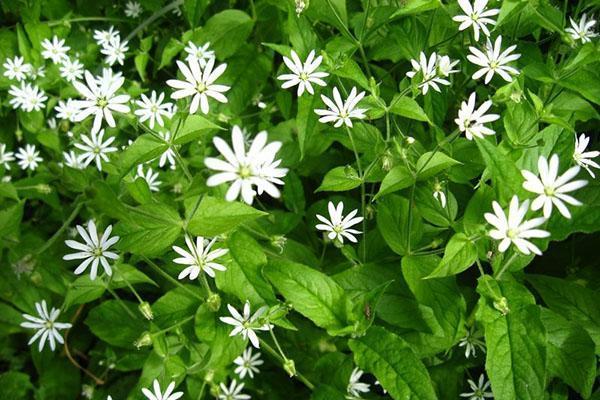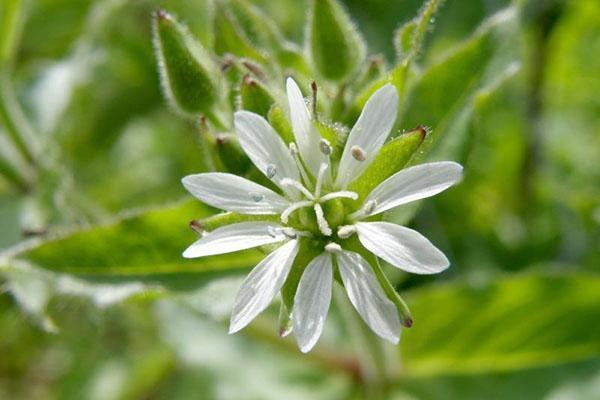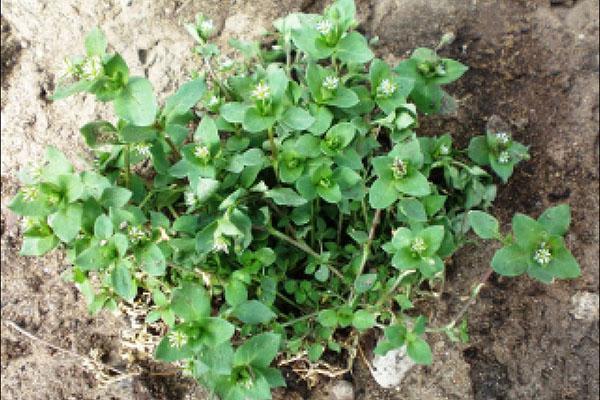All about starfish: types, useful properties and procurement rules
 Stellate belongs to a group of flowering plants of the clove family. Its flowers are white. The fruit is an egg-shaped or sphere-shaped capsule. The seeds of the plant are rounded, brown in color. Everyone is well aware of one of the representatives of this genus of plants - a grass called woodlice starlet, a photo of which recalls the appearance of a well-known herb.
Stellate belongs to a group of flowering plants of the clove family. Its flowers are white. The fruit is an egg-shaped or sphere-shaped capsule. The seeds of the plant are rounded, brown in color. Everyone is well aware of one of the representatives of this genus of plants - a grass called woodlice starlet, a photo of which recalls the appearance of a well-known herb.
Types of starfish
The genus contains about 200 species, growing on almost every continent and in all climatic zones, including the highlands and the tropics. Certain varieties are grown as cultivated plants for ornamental purposes. In our country, several plant species are best known.
Medium starfish

The middle wood louse blooms throughout the summer period, fruit ripening begins in July and ends in September. The herb of the plant can be used medicinally. Broths and infusions based on medium starwort have a number of remarkable properties and have the following actions:
- pain reliever;
- hemostatic;
- anti-inflammatory;
- wound healing;
- tonic;
- choleretic;
- stimulating.

Traditional healers use woodlice to treat diseases such as liver and kidney disease, cardiovascular system. This herb is an excellent antihistamine. The laxative effect of medium starlet is also used by many healers and those who prefer to cope with problems using traditional medicine methods.
Woodworm is an excellent assistant in the fight against sciatica, sprains, and rheumatism. Open wounds, skin rashes, ulcers and inflammations can also be healed with wood lice.
Cereal starwort
 The stem height of this representative of the species is no more than 40 centimeters. The sharp, opposite leaves reach 40 mm in length and 4 mm in width. Their surface is slightly rough. The flowers of the plant are small, white, forming spreading inflorescences.
The stem height of this representative of the species is no more than 40 centimeters. The sharp, opposite leaves reach 40 mm in length and 4 mm in width. Their surface is slightly rough. The flowers of the plant are small, white, forming spreading inflorescences.
Cereal stellate blooms from mid-May to late August. You can see this plant in the Caucasus, Siberia, the European part of Russia and Central Asia. The territories on which it grows are vast: these are meadows, meadows, the shores of lakes and rivers. The plant prefers moist soils.
Alternative medicine uses both the stems and the leaves and flowers of the plant. Collected during flowering, the grass must be well dried in a room that is regularly ventilated.
The plant is considered poisonous, therefore, cereal starlet should be used very carefully.
Cereal starweed is an excellent general tonic, which is recommended for people over 60 years old, as well as for people with heart and thyroid diseases. The herb tincture can be prepared with vodka, using the remedy as an analgesic and antitussive agent.
Oak starwort
 This type of starlet is a perennial plant with deep, but very thin rhizomes. The stems of the plant are erect, their height can reach 60 centimeters.
This type of starlet is a perennial plant with deep, but very thin rhizomes. The stems of the plant are erect, their height can reach 60 centimeters.
The plant is pubescent, its single flowers are white, and the leaves are heart-shaped, pointed. Oakgrass starlet blooms from May to early September. You can see the plant in Asia Minor, Europe, and the Caucasus. The growing areas are characterized by rich and loose soils: mainly peatlands, river banks, coniferous or deciduous forests.
The beneficial effect of oak starwort is clearly defined:
- treatment of fungal diseases;
- assistance with therapy during the development of oncological diseases;
- antiseptic treatment of infectious skin diseases.
The plant is poisonous, so the dosage must be chosen with great care.
Hard-leaved stellate
 The second name of this type of plant is lanceolate stellate. It is a short plant with a thin creeping rhizome. The fragile stem can be ascending or erect. The pointed leaves reach a size of 70 mm and are very tough: they are very strong.
The second name of this type of plant is lanceolate stellate. It is a short plant with a thin creeping rhizome. The fragile stem can be ascending or erect. The pointed leaves reach a size of 70 mm and are very tough: they are very strong.
The photo of the lanceolate starlet is very beautiful. Flower diameter - up to 3 mm, color - white. The corolla is almost twice as large as the calyx. The flowering of the plant can be observed from April to June. The places in which the stiff-leaved stellate grows are the western part of Siberia, Asia Minor, the Caucasus, Iran, and even Africa (the northern part).
Stiff-leaved stellate is a plant that is considered a melliferous and a forage plant at the same time, and abuse can lead to poisoning of animals, such as horses.
Useful properties and application
 Almost all types of stellate have a number of properties useful for humans:
Almost all types of stellate have a number of properties useful for humans:
- anti-inflammatory;
- choleretic;
- laxative;
- antimicrobial;
- diuretic (diuretic);
- hemostatic;
- hypotensive.
Stellate is good in combination with other herbs. A wonderful pair of woodlice can be plantain and horsetail. You can use herbal decoctions for the following health problems:
- coughing;
- hemorrhoids;
- cystitis;
- damage to the skin (externally);
- rashes (externally);
- inflammation of the eyes;
- swelling;
- hernia;
- vegetative-vascular dystonia;
- scurvy;
- hepatitis.
Also, stellate is used as a means to prevent the development and progression of atherosclerosis, as well as to promote faster healing of trophic ulcers.
Starfish composition
 The composition of the herb is rich in various useful substances:
The composition of the herb is rich in various useful substances:
- Vitamins. Vitamin C is involved in the normalization of metabolic processes, vitamin E is necessary for the prevention of cancer and strengthening the immune system, vitamin K helps to strengthen the walls of capillaries and regulates blood coagulation.
- Microelements. Carotene strengthens the cardiovascular system, protects the body from the development of malignant tumors. Magnesium makes the muscular system calmer and also helps to normalize the activity of nerve cells. Copper is able to provide high-quality regeneration and growth of body tissues. It also (copper) delivers iron to various tissues of the body. Iron is involved in tissue respiration and is involved in the synthesis of hemoglobin.
- Tannins. They have an anti-inflammatory effect, and are also able to disinfect the body, bind and remove salts of heavy metals. Also, this group of substances is a guarantee of a quick stop of blood in case of injury and counteraction to the poison that bees produce at the time of the sting.
- Alkaloids. Their biological effect is very strong. In the composition of stellate, these substances are able to influence the process of excitation of the nervous system, are able to relieve pain and have a mild expectorant and diuretic effect.
- Essential oils.Their content in stellate is quite high. They are designed to provide antimicrobial effect, tone the body, rejuvenate it, promote the removal of excess fluid and keep warm.
Flavonoids are also a part of stellate, which are involved in the regulation of the permeability of the walls of blood vessels and help reduce their fragility. The beneficial properties of the middle wood lice starlet will help support the body and help strengthen the immune system.
Collection and procurement
 Many types of starwings are considered poisonous, so rubber gloves should be used during the harvesting process. This is a good way to keep your hands safe. Garden shears are also important tools, with the help of which it is necessary to cut the raw material in the required volume.
Many types of starwings are considered poisonous, so rubber gloves should be used during the harvesting process. This is a good way to keep your hands safe. Garden shears are also important tools, with the help of which it is necessary to cut the raw material in the required volume.
The grass should be cut at a time when its bloom reaches its climax. After harvesting the material, you should start processing the material, which consists in processing the leaves, sorting, removing the rotting and darkened leaves and stems.
 After the plant has been cut into small leaves, it must be put into the dryer. The optimum temperature is 50 ABOUTC. This will be enough so that the raw material does not dry very quickly and retain all its useful properties. After drying, the grass is taken out of the drying chamber and placed in cloth bags.
After the plant has been cut into small leaves, it must be put into the dryer. The optimum temperature is 50 ABOUTC. This will be enough so that the raw material does not dry very quickly and retain all its useful properties. After drying, the grass is taken out of the drying chamber and placed in cloth bags.
Do not tamp dry stars in bags, because moisture will not be able to evaporate, and the material will become damp.
Store bags of grass in a warm, dry place for no more than two years. After this period, the plant loses all its beneficial properties, and the preparation of medicinal decoctions will become meaningless.